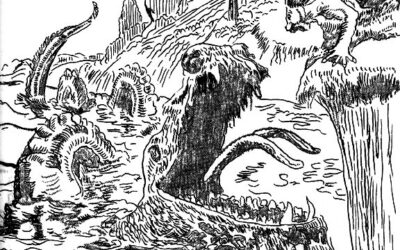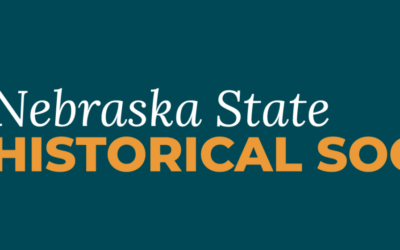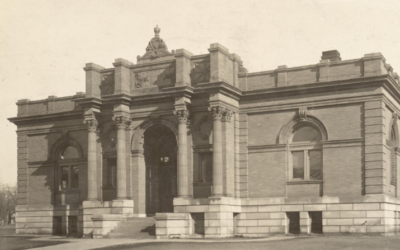HISTORY NEBRASKA MANUSCRIPT FINDING AID
RG5440.AM: Adams-Douglass-Vanderzee-McWilliams Families
Papers: 1846-2003
Lincoln, Lancaster County, Neb.; Topeka, Kan.:
Size: 0.5 cu.ft.; 1 box
BIOGRAPHICAL NOTE
Frederick Douglass and Ruth Cox were born between 1817 and 1818 in Talbot County, along the Eastern shore of Maryland. Both were born into slavery. Douglass was sent to Baltimore to work as a house servant for Hugh and Sophia Auld, relatives of his “Master” Captain Aaron Anthony. Cox too became a house servant, tending to the needs of the children of the Fitzhugh Lee family and working as a seamstress. Douglass escaped from slavery in 1838. While enslaved he had held “Sunday School” classes in which he taught literacy skills and the need for liberation to fellow enslaved men and women. By 1941, Douglass had been hired by the Massachusetts Anti-Slavery Society to work as a professional abolitionist on its lecture circuit.
In 1840, Ruth Cox [Adams] escaped from slavery. In her autobiographical writings, she recalls having heard Douglass speak against slavery, and remembered his having met her during her escape North. She believed that Douglass had helped to orchestrate her escape. Douglass was convinced, at the time, that Ruth was one of his sisters, who had been sold into slavery. He gave Ruth the name Harriet (also his mother’s name) and took her to live with his wife and children at their home in Lynn, Massachusetts. In addition to resembling his sisters, “Harriet” had a brother named Leon Bailey. Bailey had been Douglass’ name under slavery, before he changed it after his escape. It seems likely that Harriet’s brother may have been a cousin of Douglass’.
Adams served as a tutor at the Douglass home from 1840 until her marriage to Perry Adams in 1847. By this time Douglass had become an internationally renowned lecturer. After passage of the Fugitive Slave Law in 1850, the Adams moved to Haiti for a few years to avoid recapture and return to slavery. Douglass became the preeminent leader of African Americans for his vocal condemnation of slavery and of the Fugitive Slave Law. He was a friend and supporter of John Brown, and had to flee the country to avoid being arrested for conspiracy in the Brown Plot (of which he was innocent). During the Civil War Douglass worked as a recruiter and after the war he held several patronage posts with the Federal government. He lost some status in the Afro-American community in the late 1870s because of his disapproval of the Exodus of Blacks out of the South. In the meantime, Adams’ husband had died, and she joined her daughter, Matilda Ann and her son-in-law, William Vanderzee, in migrating west, to Omaha, Nebraska, in 1884. The Adams’ and Douglass’ fell out of touch for nearly ten years. Then in 1893, after lecturing at the Chicago World’s Fair, Douglass tried to find Adams in Omaha. He was unsuccessful but learned from a Norfolk newspaper shortly afterward of her whereabouts. They re-established correspondence but were not to meet again as Douglass died in 1895. Adams lived until 1900 and was buried at Wyuka Cemetery in Lincoln, Nebraska.
The lives of Ruth Cox Adams’ offspring turned out to be as interesting and exceptional as her own. Adams’ daughter, Matilda Ann, married William Henry Vanderzee who could trace his ancestry on one side of the family back to Holland. Like Matilda, W. H. Vanderzee had been raised in an anti-slavery home. His father, William, had held a sympathy meeting in Davenport, Iowa, when John Brown was hung after his raid on Harper’s Ferry, and W.H. recalled that his father had circulated a petition for the leaders of that city to provide a decent school for African American children. Matilda Ann and W.H. Vanderzee became homesteaders in Holt County, Nebraska, but due to William’s eye problems (he eventually became completely blind) they moved to Lincoln, Nebraska. The Vanderzees had four children: Anna, Perry Francis, William, and Ruth Elizabeth. Perry Francis became a seaman on Marcus Garvey’s Black Star Shipping Line during the 1920s. Garvey’s ships transported passengers between the West Indies and the United States, and the Line also organized voyages that would carry African American emigrants “back to Africa.”
Ruth Elizabeth was extremely well educated, graduating from the Cotner University School of Music in 1909 as a celebrated concert pianist. She married Ralph W. McWilliams in 1910 and in doing so joined the McWilliams family, one of the earliest families of Black homesteaders in the area. Although she was a wife and mother in the early part of the twentieth century, Ruth Elizabeth refused to retire from public life. She became a columnist for The Nebraska Farmer in the 1920s, writing an advice column for farmwomen. She also encouraged the writing of her family’s history and contributed to the publication of a feature story in the Lincoln Journal (June 5, 1927) on the McWilliams family’s migration to the Midwest after slavery.
The Vanderzee-McWilliams children worked to preserve their family history and their special link to the illustrious nineteenth century spokesman for African American people, Frederick Douglass. It was they who donated the original Douglass-Adams correspondence to the Library of Congress. Only photocopies of those letters are available in the History Nebraska collection (see Series 1).
SCOPE AND CONTENT NOTE
The Adams-Douglass-Vanderzee-McWilliams Collection is organized into three series: 1) Adams-Douglass Materials; 2) Vanderzee-McWilliams Materials; and 3) Research and Genealogical Materials.
Series 1, the Adams-Douglass Materials, contains seven folders:
Folders 1 and 2 are comprised of photocopies of correspondence between Frederick Douglass and Harriet Bailey [aka Ruth Cox Adams], the matriarch (mother and grandmother) of the Vanderzee and McWilliams families who are the subjects of Series 2. The letters in these folders are copies and/or transcriptions of the originals. The earliest letter is dated May 1846 and was sent by Frederick Douglass to “Harriet Bailey” who was staying at his home in Lynn, Massachusetts. Frederick Douglass was then touring the British Isles as a professional abolitionist for the Massachusetts Anti-Slavery Society. At least three of the surviving letters were mailed by Douglass to “Harriet” from abroad. Other letters in the series were sent from members of the Douglass household addressed to “Harriet” [aka Ruth Cox Adams] after her marriage to Perry Adams in 1847. The correspondence between the Douglass and Adams families continued up to 1894, the year before Douglass’ death.
Folder 3, Biographical and autobiographical materials, is made up of drafts of an essay, entitled “Lest We Forget” (printed in 1978), describing Adams’ escape from slavery, her introduction to and adoption by the Frederick Douglass family, her marriage and eventual move West. Adams herself wrote one of the drafts; her granddaughter Alice (Vanderzee) Coffee wrote the final version.
Folder 4, Publications, holds a copy of a booklet by Rosetta Douglass Sprague about her mother and Frederick Douglass’ wife, Anna Murray Douglass. This document provides a rare view of Anna Douglass’ personality, and its contents may challenge current scholarship on the wife and family life of the great abolitionist.
Folder 5 contains copies of photographs of Frederick Douglass and of the library in his home at Cedar Hill, Anacostia, D.C. Folder 6 holds newspaper clippings on Douglass’ speeches, career, and death, and folder 7 is made up of calling cards, a letter of recommendation for Adams’ husband and other miscellany.
Series 2 contains the Vanderzee-McWilliams Materials. The members of these families are the lineal descendants of Ruth Cox Adams.
Folders 8 and 9 hold a graduation certificate of the prolific writer and pianist, Ruth Elizabeth (Vanderzee) McWilliams, and newspaper clippings. Folder 10 contains a scrapbook of newspaper articles, authored by Ruth Elizabeth McWilliams often under the pen name “Elizabeth Mack.” The articles are primarily advice columns. Folder 11 consists of misc. publications relating to the photographer James Van DerZee.
Folder 12 holds Vanderzee-McWilliams family correspondence, and folder 13 contains correspondence between family members about how to best preserve the history of their grandmother Ruth Cox Adams’ escape form slavery and her adoption into the Frederick Douglass household.
Folder 14 is comprised of Vanderzee-McWilliams biographical materials including a description of Matilda Ann Vanderzee’s initial reaction to life as a homesteader’s wife. Folder 15 holds newspaper clippings of the Vanderzee-McWilliams family and their relationship to the establishment of African American churches in Lincoln.
Folder 16 is made up of the eulogies of Vanderzee-McWilliams family members, and records of cemetery plots. Folders 17 and 18 hold newspaper clippings and a copy of a letter from John Brown, written shortly before his execution. Folder 19 contains calling cards and other miscellany.
Series 3 is made up of four folders of misc. genealogy and research materials: Folder 20, Douglass-Adams-Vanderzee-McWilliams Research contains data about the families that was collected by professional researchers. Folder 21 holds Publications and Reports written about the families. These materials were included in the collection to provide researchers with information which collection assemblers and students of the Adams-Douglass-Vanderzee-McWilliams families have found, but which may not otherwise be accessible to the public.
Folder 22, Cox-Adams-Vanderzee family genealogies, contains information on Ruth Cox Adams’ marriage, the dates of her children’s births and her husband’s death. Folder 23 contains Vanderzee-McWilliams genealogies. The Vanderzee-McWilliams families are able to trace their ancestry back to 1607.
Note: For photographs, please see the photo component [RG5440.PH].
INVENTORY
Series 1 – Adams-Douglass Materials
Box 1
Folder
- Correspondence, Adams-Douglass, 1846-1895 [photocopies only]
- Correspondence, Cox-Adams-Bruce, 1863-1890
- Biographical and autobiographical materials, 1817-1900
- Publications, 1900, and undated
- Photos [copies only]
- Newspaper clippings, 1893-1899
- Miscellany, 1861-1967
Series 2 – Vanderzee-McWilliams Materials
- Ruth Elizabeth (Vanderzee) McWilliams, certificates, 1909
- Ruth Elizabeth (Vanderzee) McWilliams, clippings, 1927-1967
- Ruth Elizabeth (Vanderzee) McWilliams, scrapbook
- James Van DerZee, publications, 1972-1973
- Correspondence, family, 1870-1978
- Correspondence regarding Douglass-Adams documents, 1966-1986
- Biographical materials, undated
- Newspaper clippings, 1961-1979, and undated
- Eulogies and cemetery plots 1860, and undated
- John Brown, letter, 1859
- John Brown, clippings, undated
- Misc. addresses, calling cards, etc., 1864-1966, and undated
Series 3 – Research and Genealogical Materials
- Research, Douglass-Adams-Vanderzee-McWilliams, 2002-2003
- Research, reports and publications, 2003-2004
- Genealogy, Cox-Adams-Vanderzee, 1798-1992
- Genealogy, Vanderzee-McWilliams, 1607-1933
Subject Headings:
Abolitionists — United States
Adams Family
Adams, Ruth Cox
African American churches –Nebraska — Lincoln
African Americans — Nebraska
Brown, John, 1800-1859
Christian Church — Disciples of Christ
Douglass Family
Douglass, Frederick, 1817?-1895
McWilliams Family
McWilliams, Ruth Elizabeth (Vanderzee)
Vanderzee Family
07-20-2007 Revised TMM/tmm




